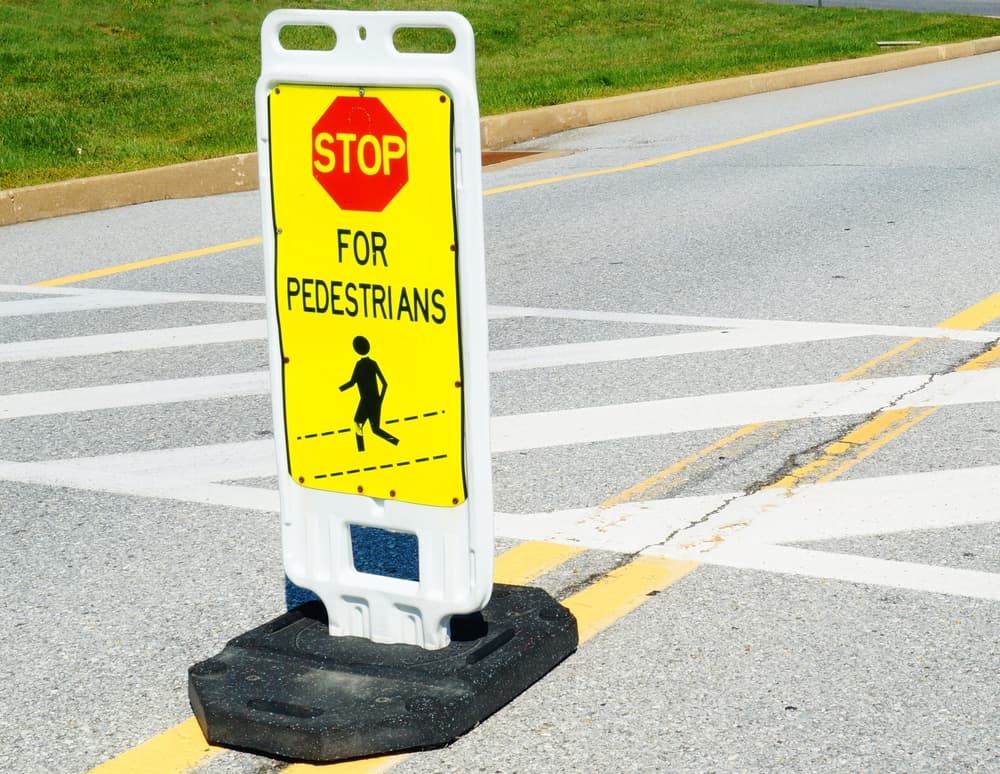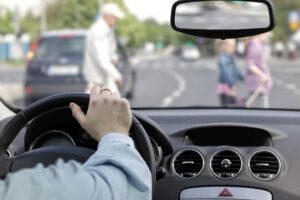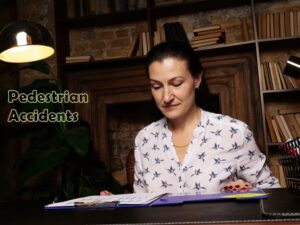Do Pedestrians Always Have the Right of Way?

Pedestrians usually have the right of way in Texas, especially when they cross the street in marked or unmarked crosswalks or at intersections without traffic signals or signs indicating right-of-way. Motorists have a responsibility to carefully watch for people crossing the street or walking along the roadway to avoid causing injuries, even when the pedestrian doesn’t have the right of way.
When a car versus pedestrian collision occurs, the driver is generally. The pedestrian can hold them accountable and recover compensation by filing a claim based on their auto liability insurance policy or suing them in civil court. Pedestrian accident lawyers handle these cases frequently.
Drivers Have a Responsibility to Watch for Pedestrians
 In Texas, drivers have many responsibilities when it comes to pedestrians. Many of these responsibilities come from laws in the Texas Transportation Code. These laws establish a duty of care that motorists owe pedestrians. This is one of the four elements necessary to show that negligence occurred and hold a party liable for accident injuries.
In Texas, drivers have many responsibilities when it comes to pedestrians. Many of these responsibilities come from laws in the Texas Transportation Code. These laws establish a duty of care that motorists owe pedestrians. This is one of the four elements necessary to show that negligence occurred and hold a party liable for accident injuries.
Some of the responsibilities drivers have to protect pedestrians include:
Yielding the Right of Way
Drivers must yield the right of way to pedestrians legally crossing the street in a marked or unmarked crosswalk. Some areas take steps to make it easier to know there is a pedestrian preparing to cross or in the crosswalk.
For example, Austin, TX, has installed pedestrian hybrid beacons in some busy crosswalks. These signals have two red lights above a single yellow light. The pedestrian triggers the beacon before crossing.
Stopping for Pedestrians in a Crosswalk
Drivers must stop for pedestrians crossing the roadway within a marked crosswalk or at an unmarked crosswalk at an intersection. They must remain stopped until the pedestrian has safely crossed their half of the roadway.
Yielding to Pedestrians at Intersections
At intersections with no traffic signals or signs indicating right-of-way, drivers must yield to pedestrians crossing the street. This is true even in places with no marked crosswalks. Failing to yield when turning is a common cause of pedestrian collisions.
Exercising Due Care
Drivers must exercise due care to avoid colliding with any pedestrian on a roadway. This includes slowing down in areas with high pedestrian traffic and passing pedestrians walking along roads cautiously.
Using Extra Caution in School Zones
In school zones and at school crossings, drivers must exercise extra caution and strictly adhere to reduced speed limits and other regulations designed to protect children and teens. When a crossing guard is present, motorists should obey their directions and proceed only when told to do so.
Not Passing Stopped Vehicles
When passing a vehicle stopped at a crosswalk, drivers must also stop at the crosswalk. This is a particularly dangerous situation for pedestrians. Motorists should not proceed past the stopped vehicle until they can do so safely without endangering pedestrians.
Being Mindful of Special Populations
Some pedestrians are more at risk of injury accidents than others. Drivers must be particularly cautious of children, seniors, those using mobility devices, and blind pedestrians. Motorists should stop completely and allow the pedestrian to clear their half of the roadway before proceeding.
Failure to adhere to these responsibilities can cause pedestrian accidents, which often result in catastrophic injuries or even death. Pedestrians are at serious risk of injury when an accident occurs. Not only is it the law, but pedestrian safety relies on drivers being attentive and giving pedestrians the right of way.
Why Do Pedestrians Often Have the Right of Way?
Car versus pedestrian accidents often result in devastating consequences for pedestrians and their families. When a driver makes a mistake behind the wheel, such as failing to yield the right of way in a turn, there is little a pedestrian can do to protect themselves. They are likely to suffer serious injuries.
A few reasons why include:
- Size and Weight Disparity: A car’s size and weight are much, much greater than a person’s. This is especially true when considering large SUVs, cargo vans, and trucks. Even at low speeds, a vehicle hitting a pedestrian can cause severe injuries or fatalities.
- Lack of Protection: Unlike vehicle occupants, who are protected by seat belts, airbags, and metal framing, pedestrians have no protection. They are directly exposed to the impact, making significant injuries more likely.
- Types of Injuries Possible: The impact of the vehicle often causes traumatic, life-altering injuries. Injured pedestrians often require emergency medical care and stabilization with head injuries, spinal cord injuries, internal organ damage, severe lacerations, and other traumatic injuries.
- Numerous Forces Involved: Pedestrians struck by vehicles often impact other objects, as well. This could include pavement, other vehicles, or nearby objects. This causes additional injuries.
- Complex Trauma: Pedestrian accidents often cause complex trauma, where multiple body systems suffer injuries affected simultaneously. This can complicate treatment and recovery, requiring care and rehabilitation at a trauma center.
- Speed: The vehicle’s speed is a critical factor in the severity of the pedestrian’s injuries. Higher speeds increase the force of impact and the likelihood of severe or fatal injuries.
- Vulnerability of Certain Pedestrians: Certain groups of pedestrians, such as children, elderly individuals, and those with disabilities, are particularly vulnerable in car versus pedestrian accidents. They are also among the most likely to be using sidewalks and crosswalks to commute.
The significant risks to a pedestrian hit by a car underscores why so many cities and states promote awareness campaigns and install pedestrian safety devices. Reducing the frequency and severity of such accidents relies heavily on driver behavior. Inattentive, careless, and reckless drivers create dangerous circumstances for pedestrians, who often suffer lasting injuries in these collisions.
How Do Motorists Cause Pedestrian Collisions?
Pedestrians may seem to always have the right of way because a driver’s carelessness usually causes a collision. There are several common ways this happens:
Failure to Yield Right of Way
Drivers who fail to yield the right of way to pedestrians at crosswalks and intersections are one of the most common causes of pedestrian accidents. This often occurs when the driver is turning and fails to see a pedestrian crossing the street.
Distracted Driving
Smartphones and other electronic devices can distract both drivers and pedestrians. While pedestrians need to pay careful attention to their surroundings, texting, using social media, or talking on the phone while driving can be deadly.
Speeding
Drivers traveling at excessive speeds in residential areas, near schools, or in busy urban areas are at higher risk of causing a pedestrian accident. These areas have a high number of pedestrians, and drivers must carefully watch for people crossing the street.
Drunk or Drugged Driving
Alcohol or drug impairment significantly increases the risk of accidents. Drivers who are under the influence of drugs or alcohol have impaired judgment and reaction times. This makes it more difficult to recognize a situation that puts a pedestrian in danger and act accordingly.
Failure to Obey Traffic Laws
When drivers disregard traffic laws, it greatly increases the risk of a collision. This includes pedestrian accidents. Some examples include running red lights, ignoring stop signs, passing on the shoulder, and failing to yield when turning.
Poor Visibility
Drivers must take extra precautions when traffic, weather, or their surroundings make it more difficult to drive safely. Rain, fog, darkness, heavy downtown traffic, and obstructed views all call for slowing down and being cautious. Failure to do so could contribute to causing a pedestrian collision.
Who Is Legally Liable for a Pedestrian Accident?
Both drivers and pedestrians must respect each other’s rights and responsibilities to prevent accidents. However, when accidents occur, the motorist is usually liable. This means they pay for the damages suffered by the pedestrian.
Four elements are necessary to hold a driver accountable for an accident.
They are:
- They owed the pedestrian a duty of care
- They breached this duty
- This breach caused the accident
- The victim suffered harm
For example, we know Texas law requires drivers to stop for pedestrians crossing at an intersection. When a driver fails to recognize someone crossing the road and continues their left turn, this often causes a car versus pedestrian collision. The victim could suffer serious or catastrophic injuries.
By documenting that the motorist acted negligently, the victim can seek compensation for their accident-related expenses and losses.
This could include:
- Medical treatment, current and future
- Lost income
- Diminished earning capacity
- Property damages
- Additional costs
- Pain and suffering damages
How to Recover Compensation After a Pedestrian Accident
There are generally two ways an injured pedestrian can hold an at-fault driver accountable and recover compensation: an insurance settlement or a civil court award. Insurance settlements are the most common.
According to the Texas Department of Insurance (TDI), all motorists in Texas should have auto liability insurance coverage or some other form of financial responsibility for accidents they cause.
The required minimum policy in Texas includes:
- $30,000 for one victim’s medical bills
- $60,000 for all victims’ injuries
- $25,000 to cover other vehicles damaged in a crash
An injured pedestrian can ask the driver’s insurance carrier to cover their costs, negotiating with them until they reach an agreement. Alternatively, a personal injury lawsuit and trial puts the decision in the hands of a judge or jury.
Managing a Pedestrian Accident and Injury Case Is Difficult on Your Own
 While handling a pedestrian accident injury case without a lawyer is possible, it is rarely in the victim’s best interest. Most victims lack the necessary knowledge and experience, and navigating the process is often overwhelming and frustrating. This is especially true when they are undergoing treatment, or their loved one has catastrophic, life-altering injuries.
While handling a pedestrian accident injury case without a lawyer is possible, it is rarely in the victim’s best interest. Most victims lack the necessary knowledge and experience, and navigating the process is often overwhelming and frustrating. This is especially true when they are undergoing treatment, or their loved one has catastrophic, life-altering injuries.
Hiring a pedestrian accident lawyer can significantly improve the chances of recovering the money they need to pay for their care. Victims deserve fair compensation for their injuries and losses. Personal injury law is complex, and victims without legal training may not fully understand their rights and the legal processes involved in pursuing a claim.
Dealing with the aftermath of a pedestrian accident is challenging enough for victims and their families. There are physical and emotional needs to consider. Many continue to undergo rehabilitation. Letting a trusted law firm handle the legal case allows them to focus on their treatment and healing.
How a Pedestrian Accident Lawyer Benefits an Injury Case
Having a pedestrian accident lawyer handle your case means you do not have to worry about the intricacies of navigating the claims process. They will take care of your case from start to finish, including the parts that would be challenging or impossible for you to manage on your own.
You can trust your lawyer to:
- Deal with the Insurance Company: Lawyers understand the tactics used by insurance adjusters and can negotiate effectively to fight for fair compensation.
- Identify the Liable Parties: Lawyers can assess the circumstances of the accident, identify potentially liable parties, and gather evidence to develop a case against them.
- Build a Compelling Case: Building a strong case requires thorough investigation and gathering of evidence, including police accident reports, witness statements, medical records, and documentation of damages.
- Value Your Damages: Calculating the full extent of damages in a pedestrian accident case requires assessing both economic and non-economic damages and working with experts to estimate future expenses.
A pedestrian accident attorney will handle your case from start to finish. Once they have a convincing argument to show how the at-fault driver caused your crash and injuries, they will demand fair compensation from the insurance carrier and negotiate a settlement, file a personal injury lawsuit, or take other necessary action to get justice for you.
Discuss Your Pedestrian Accident Injuries With Our Team for Free

Ted R. Lorenz, Pedestrian Accident Lawyer
The personal injury lawyers at Lorenz & Lorenz Accident & Injury Lawyers PLLC, provides free consultations for pedestrian accident victims and their families. We will assess your case and explain how we can help. In addition to our Austin headquarters, we have locations in San Antonio and Waco, TX.
Contact us today to get started. Dial (512) 477-7333.
